Exploring Honolua Bay: Maui's Marine Paradise
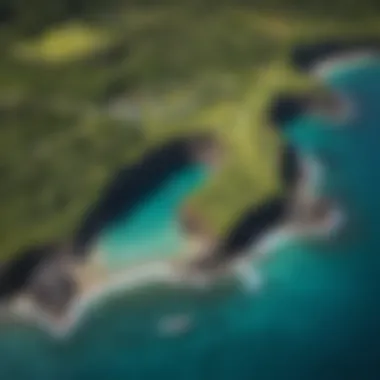
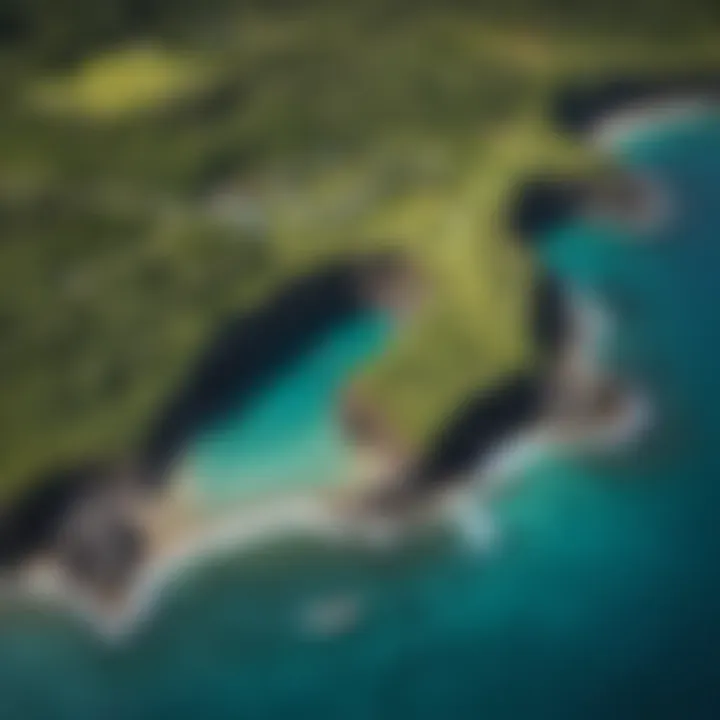
Intro
Nestled on the northwestern coast of Maui, Honolua Bay is not just another name on a map. This marine preserve stands out for its striking scenery and rich ecosystem. Often considered a hidden gem, it attracts a diverse crowd ranging from seasoned explorers to families seeking fun in the sun. Whether you’re an avid snorkeler or someone simply looking to soak in nature’s grandeur, Honolua Bay offers something for everyone.
The bay itself, framed by lush greenery and dramatic cliffs, provides an idyllic backdrop for various water sports. Beyond its beauty lies a robust marine habitat teeming with life, making it a hotspot for ecological study and conservation efforts. With the aim to shed light on these unique characteristics, this article will guide you through the ins and outs of Honolua Bay.
As we take a closer look at this multifaceted jewel, it becomes clear that understanding the geographical and cultural context is essential to appreciating its true value. We will explore the mesmerizing marine life, delve into the popular water sport activities, and touch on the pressing need for sustainable practices to protect this delicate ecosystem. This narrative is not merely an information dump; it seeks to evoke respect for a natural wonder that is as much a part of Hawaii’s culture as it is a haven for aquatic adventures.
In this exploration, it’s important to highlight the significance of every aspect—from the gear you need to embark on your journey, techniques for making the most out of your experience, to understanding how to be a responsible visitor. These threads will weave together an informative tapestry that beckons both visitors and locals alike to experience Honolua Bay with umatched appreciation.
Location and Formation of Honolua Bay
Honolua Bay's allure is undeniably tied to its location and formation, intertwining natural beauty with ecological significance. Situated on Maui's northwestern coast, this bay not only serves as a picturesque spot for relaxation but stands as a crucial marine preserve, fostering a rich biodiversity. Understanding its geographical context and geological history provides valuable insights into what makes this site a cornerstone of Maui’s ecological and recreational landscape.
Geographical Overview
Located near the tranquil town of Kapalua, Honolua Bay is enveloped by rugged cliffs and lush vegetation, creating a stunning panoramic view that captures the essence of Hawaii's natural beauty. This bay is characterized by its crescent shape, a feature that not just enhances its aesthetic appeal but also plays a vital role in the natural ecosystem. The bay is approximately a mile long, with its waters protected from the open ocean's swells, allowing for a more serene environment where diverse marine life can flourish.
The waters of Honolua Bay are concealed within a state marine conservation district, ensuring that the ecosystems housed here receive protection from harmful activities such as overfishing or pollution. This geographical advantage is a linchpin for maintaining the bay's clarity and health, attracting visitors from around the globe—particularly those with a penchant for snorkeling and diving. The bay's gentle currents and vibrant underwater habitats transform it into a haven for marine exploration.
Key Features:
- Crescent Shape: Provides natural protection from wind and waves.
- Marine Conservation District: A shield against destructive practices.
- Diverse Habitats: From coral reefs to sandy bottoms, the bay supports a variety of marine life.
Geological History
Diving into the geological history of Honolua Bay unravels a tale that dates back millions of years. The bay is the product of volcanic activity, a testament to the mighty forces that shaped the Hawaiian Islands. Formed over time through volcanic eruptions and the subsequent erosion of the land, the rocks and cliffs that frame the bay tell the story of Earth's geological past.
The unique topography of Honolua Bay is a reflection of lava flows that solidified and eroded into the steep cliffs visible today. These cliffs are not just dramatic backdrops; they provide crucial habitats for seabirds and contribute to the overall biodiversity of the region. The bay itself boasts underwater structures resembling fingers extending into the depths, supporting vibrant coral that serve as the backbone of its marine ecosystem.
In a nutshell, the interplay between geology and ecology at Honolua Bay creates a sanctuary that fosters rich marine biodiversity, while also providing a stunning locale for both adventure and relaxation. "Understanding these elements contribute not only to our appreciation of Honolua Bay but also to our commitment to preserving its exceptional natural beauty for future generations."
"Maui's Honolua Bay is a living testament to the power of nature, where every wave and rock has a story to tell."
Through recognizing these facets of location and formation, visitors can grasp the interconnectedness of this unique area, prompting a deeper respect for its ecological treasures.
Marine Biodiversity at Honolua Bay
Marine biodiversity is a cornerstone of any healthy marine ecosystem, and Honolua Bay is no exception. This cove bursts with life, hosting a vibrant tapestry of marine creatures, coral formations, and ecological interactions that not only enrich the area but also serve as essential resources for both the environment and local communities. From the surface to the ocean floor, the bay acts like a natural laboratory, providing a window into the intricate relationships that sustain life in the sea and the delicate balance that needs to be maintained.
Coral Reefs and Their Importance
Coral reefs are often likened to the rainforests of the ocean. They are complex ecosystems formed by tiny coral polyps that live symbiotically with algae. At Honolua Bay, these expansive coral gardens play a pivotal role in maintaining marine diversity. They act as nurseries for many species of fish, offering them shelter and food resources in their formative stages.
These reefs also help to protect shorelines from erosion by absorbing the energy of incoming waves. Studies reveal that healthy reefs can reduce wave impact by up to 97%. This not only safeguards the coastline but also benefits those who venture into the bay for leisure activities such as surfing, snorkeling, and diving. Without the reefs, the entire marine ecosystem would be at risk, further highlighting their crucial position in the area.
Species Diversity
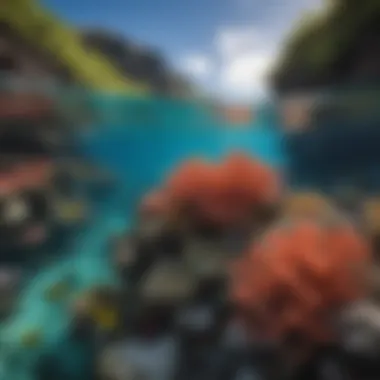
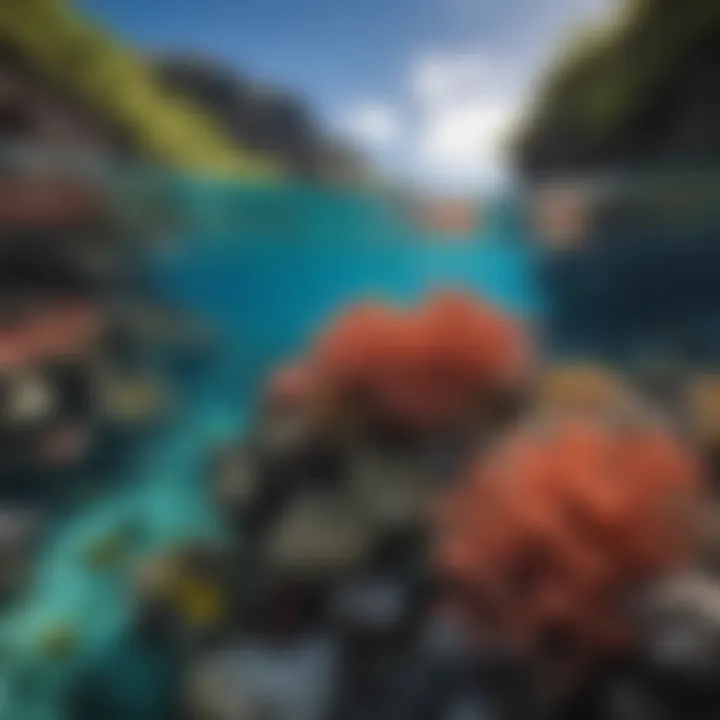
Honolua Bay is a sanctuary for a plethora of species, each contributing a unique element to the ecological puzzle. Fish like the Hawaiian yellow tang and various species of butterflyfish flutter about, while larger inhabitants such as Hawaiian monk seals and green sea turtles frequent the waters. The biodiversity is not limited to just fish; crustaceans, mollusks, and numerous species of marine invertebrates can be found both on the reef and among the sandy bottom.
This diversity ensures resilience in the ecosystem. Different species fill various ecological niches, making the entire system more robust against pressures such as climate change, pollution, and invasive species. When one population declines, others can sometimes adapt or fill that void. In this way, the marine life at Honolua Bay showcases the beauty of nature’s complexity.
Understanding Marine Ecosystems
A marine ecosystem is not just a collection of plants and animals; it is a web of interactions and dependencies. Understanding these dynamics is essential for conservation and for informing sustainable practices. Honolua Bay serves as an excellent model for studying these relationships.
Each organism within the bay, from the smallest plankton to the largest predators, plays a role in nutrient cycling and energy transfer. For example, herbivorous fish manage algae growth on reefs, which helps keep corals healthy. In turn, corals provide shelter for fish, illustrating a clear connection in this finely-tuned system.
Furthermore, human interaction also impacts these marine ecosystems significantly. Awareness of how recreational activities or environmental changes affect these relationships can lead to more sustainable practices. Engaging the community in conservation means understanding not just the 'what' and 'how' of ecological damage, but also the 'why' behind preserving these interconnected systems.
"Conserving marine biodiversity is essential not just for the health of the oceans but for the well-being of future generations."
Through education and mindful visitation, we can all do our part to ensure that Honolua Bay remains a haven of biodiversity for years to come.
Honolua Bay's Role in Watersports
Honolua Bay is not just a visual feast; it's a vibrant arena for diverse watersport activities that attract thrill-seekers and nature lovers alike. The bay's unique geographical features, coupled with its stunning marine life, make it a prime spot for various adventures on the water. From surfing the incredible waves to exploring the underwater world while snorkeling, Honolua Bay encapsulates all that makes water sports captivating. Emphasizing both enjoyment and environmental awareness, these activities contribute not just to personal exhilaration but also highlight the importance of preserving this pristine marine asset.
Surfing Opportunities
When it comes to surfing, Honolua Bay stands out as a prestigious destination on Maui. The bay's gentle, rolling waves during the summer months create ideal conditions for both novice surfers and seasoned pros. Surfers often find themselves drawn to the renowned left-handed point break, which is particularly exhilarating when the swells arrive.
However, it’s crucial to keep an eye on the surf reports; during winter, conditions can shift dramatically, giving rise to formidable waves ideal for experienced surfers seeking a challenge. Local surfers respect the surf breaks while observing proper etiquette, but newcomers might want to tag along with instructors for guidance on local customs and safety.
Snorkeling and Diving Experiences
Diving and snorkeling in Honolua Bay reveal an underwater landscape bustling with life. Just beneath the surface, vibrant coral reefs beckon adventurers to explore. The clear waters provide excellent visibility, allowing snorkelers to marvel at schools of fish darting about, sea turtles gracefully swimming, and occasionally, the gentle presence of manta rays.
For those keen on diving, the diverse ecosystems support a rich tapestry of marine species. Many dive shops around Maui offer gear rentals and guided tours, ensuring both safety and a deeper understanding of the marine environment. It is advisable to check local water conditions to ensure a safe and enjoyable experience. Not to mention, interacting with this underwater splendor cultivates not just appreciation but a genuine desire to protect and conserve these vulnerable ecosystems.
Kayaking and Paddleboarding
Kayaking and paddleboarding present yet another delightful way to enjoy Honolua Bay’s tranquil waters. Imagine gliding over the calm surface, where you can soak in the breathtaking scenery and pristine environment. Many visitors choose to rent kayaks to paddle along the coastline, offering a unique perspective on the bay’s lush surroundings.
Paddleboarding, with its blend of balance and tranquility, allows enthusiasts to maintain a connection with the water while quietly observing the marine life below. Both activities not only serve as physical exercises but also promote mindfulness and a sense of serenity amidst nature.
When engaging in these watersports, it is vital to respect the local guidelines and be mindful of the bay’s delicate environment. Practicing responsible behavior, such as avoiding contact with the corals, can help maintain the beauty of Honolua Bay for future generations.
"Honolua Bay is not just a place to enjoy water sports; it stands as a symbol of the harmony between human activity and marine conservation."
Cultural Significance of Honolua Bay
Understanding the cultural layers of Honolua Bay reveals much about the identity and history of this magnificent area on Maui. This bay isn't just a beautiful vista; it's a site steeped in traditions and historical narratives that showcase the relationship between the land, the sea, and its people. Exploring its cultural significance is essential for grasping not only the environmental importance but also the deep-rooted social connections that have persisted through generations.
Historical Background
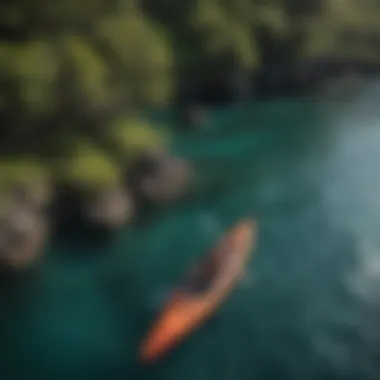
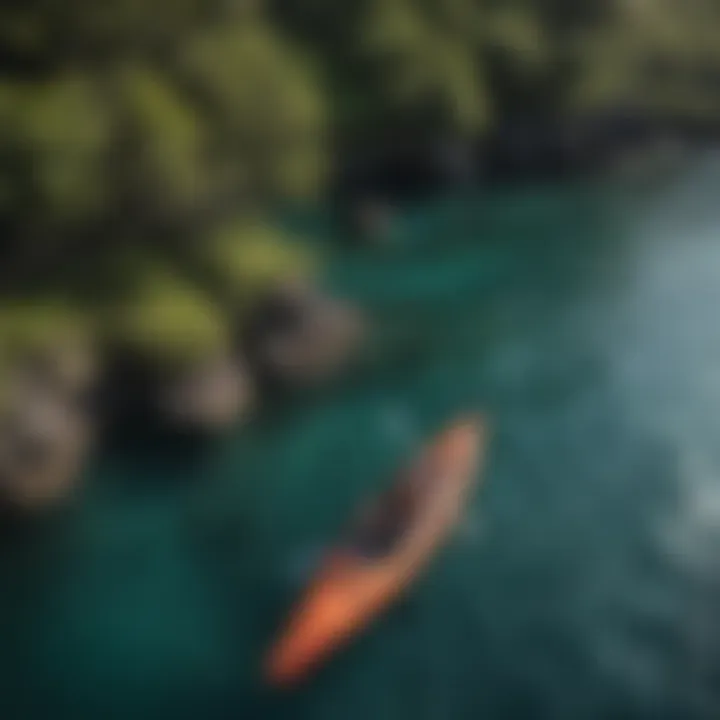
Honolua Bay has been a vital spot for the local community for centuries. Historically, it served as a refuge for native Hawaiians, providing a bounty of resources from both land and sea. Fishing practices in these waters have their roots in ancient traditions where sustainability was woven into the very fabric of existence. There were known fishing grounds, where families would gather, sharing stories and meals, strengthening bonds that are still recognized today.
In the late 20th century, many local seafood practices faced challenges due to increased tourism and commercialization. As more outsiders began to frequent these waters, the need to honor and protect local traditions surged. Education on the historical significance of Honolua Bay became paramount, creating a bridge between the past and present. Such historical contexts shape the narratives surrounding conservation efforts and community engagement in maintaining the area's ecological integrity.
“To know where you’re going, you must understand where you’ve been.” This wisdom holds true as the community navigates the challenges posed by modernity and urban development, all the while cherishing their rich history.
Cultural Practices and Traditions
The cultural practices at Honolua Bay reflect a deep reverence for nature. The native Hawaiian principles of mālama ʻāina (to care for the land) and ho‘omanawanui (to be patient) showcase a lifestyle that respects both the environment and the symbiotic relationship between people and nature. Traditional fishing techniques are still practiced; many local fishermen use methods passed down through generations, emphasizing sustainability and respect for marine life.
Festivals and ceremonies, often tied to the lunar calendar, hold their own significance in the cultural landscape. Events celebrating the sea, such as , involve offerings to the ocean, acknowledging the life it provides while also asking for its continued bounty. During such gatherings, the community comes together to share cultural performances, ensuring that stories and traditions continue to thrive.
Local artisans also contribute to this cultural tapestry, with crafts that frequently draw on the motifs of the marine environment, from intricate carvings to woven baskets made from natural materials. These crafts serve as both practical items and expressions of identity, tying individuals and families to their ancestral roots and the waters surrounding Honolua Bay.
In the modern era, cultural revitalization efforts continue to play a role in how residents perceive and engage with the space. Workshops teaching traditional practices, community meetings focused on environmental stewardship, and educational programs in schools help to pass down knowledge to the younger generations, instilling a sense of pride in their heritage and responsibility towards their environment.
In summary, the cultural significance of Honolua Bay extends far beyond its natural beauty. It represents a history of relentless adaptation, respect for nature, and a commitment to preserving both cultural and ecological integrity for future generations.
Conservation Efforts in Honolua Bay
Honolua Bay serves as a striking example of how conservation efforts can preserve marine ecosystems while fostering a sustainable relationship between nature and humanity. The bay isn’t just a pretty face; it plays a crucial role in the region's ecological health and supports a diverse range of marine life. The importance of these conservation efforts cannot be understated, as they not only protect the unique biodiversity of the area but also ensure that future generations can enjoy the wondrous sights and experiences Honolua Bay has to offer.
Protected Marine Areas
One of the key strategies in conserving Honolua Bay is designating it as a protected marine area. This classification helps mitigate the adverse effects of overfishing and habitat destruction—two of the most pressing concerns for marine environments. By limiting fishing activities, the area allows fish populations to recover and thrive. This is not just beneficial for the fish; healthy fish stocks support the entire ecosystem, including the coral reefs which are vital to the bay's biodiversity.
Research shows that when marine areas are protected, they can rebound significantly in terms of species richness and abundance. This restorative effect demonstrates the importance of designated protections.
In addition to protecting marine life, these designated areas offer a semblance of peace, allowing snorkelers and divers a safe space to explore rich underwater landscapes without adding stress to the ecosystem.
Community Involvement in Conservation
Community engagement is pivotal in the conservation narrative at Honolua Bay. Local organizations and residents are often the first line of defense in protecting their marine environment. Initiatives such as beach clean-ups and coral nurseries facilitate direct community involvement. These grassroots movements not only foster a sense of ownership but also instill valuable conservation practices among the younger generations.
"It's not just about preserving a spot in nature; it's about cultivating a culture of respect and responsibility toward our environment."
By actively involving the community, efforts become more relatable and impactful. For example, educational programs centered around marine life and the significance of ecosystems empower locals and visitors alike to become advocates for conservation.
Ongoing Research and Monitoring
Another critical aspect of conservation in Honolua Bay is continual research and monitoring. Scientists and environmentalists conduct regular surveys to gather data on marine populations, water quality, and human impact. This research is vital to understanding existing threats and preserving marine health.
Ongoing studies have observed shifts in species populations which may indicate broader environmental changes. By monitoring these trends, conservationists can adapt strategies to protect the bay effectively.
Moreover, the data collected can guide policies and inform visitors about sustainable practices. This blend of science and awareness reinforces the bond between humanity and the natural world, ensuring that Honolua Bay remains not just a tourist spot, but a thriving ecosystem.
In summary, the conservation efforts at Honolua Bay are multi-faceted and deeply interwoven with the local community. Protected marine areas keep the delicate balance of biodiversity in check, while community involvement cultivates a shared responsibility toward conservation. Backed by ongoing research and monitoring, these efforts highlight how humanity can actively participate in preserving the beauty and richness of this incredible marine jewel.
Visitor Experience at Honolua Bay
Honolua Bay is more than just a stunning landscape; it stands as a haven for adventure seekers, offering them the chance to immerse themselves in the natural beauty and thrill of Maui's northwestern coast. Understanding the visitor experience is crucial to appreciating what the bay has to offer. From breathtaking vistas to adrenaline-filled watersports, each aspect enhances the allure of the location.
Access and Amenities


Getting to Honolua Bay is relatively straightforward, but knowing the ins and outs can ensure a smooth trip. Located along the Honoapiilani Highway, the bay is easily reachable by car. There is parking available, but during peak seasons, spots fill up faster than a pot of water on a hot stove. For those who opt for public transport, keep an eye on local bus services that occasionally include stops in strategic areas leading to the bay.
Amenities are somewhat limited, which, for many, adds to the charm. While you won’t find fancy restaurants or bustling shops, there are picnic areas, restrooms, and basic facilities to accommodate visitors. It’s a wise idea to pack a cooler with snacks and drinks. Doing so elevates the experience, enabling visitors to relax and soak in the sun amidst the stunning backdrop. Bring along some shade, like a beach umbrella or pop-up tent, as the sun can get quite fierce—nobody wants to leave with more than just great memories, right?
Best Times to Visit
Timing can make or break a visit to Honolua Bay. For those looking to enjoy optimal weather and activities, late spring to early fall tends to be the sweet spot. From May to September, the air temperature is more comfortable, typically hovering around the mid-80s °F. Visitors are more likely to experience calm waters during these months, perfect for snorkeling and kayaking.
However, if the idea of witnessing dramatic wave action tickles your fancy, winter months are a treat for surfers, especially from November to March. This period sees larger swells and great opportunities for thrilling water sports. Note that while the winter months might bring some unpredictability in weather, the scenery can be downright spectacular.
"Planning is half the fun—knowing when to go can help you discover a side of Honolua Bay you might not see otherwise."
Ultimately, the choice of when to visit may hinge on what kind of experience you seek. Whether it's tranquil waters for beginners or exhilarating surf for seasoned pros, Honolua Bay offers a little something for everyone, making it a truly multifaceted jewel of Maui.
Challenges Facing Honolua Bay
Honolua Bay, with its striking beauty and ecological diversity, faces a series of challenges that threaten its delicate balance. Recognizing these challenges is crucial for anyone interested in understanding the broader implications of preserving not just the bay, but the entire Maui ecosystem. The upcoming sections aim to illuminate the key hazards faced by this marine sanctuary and the tug-of-war between the need for tourism and the preservation of its natural resources.
Environmental Threats
The threats to Honolua Bay are numerous and complex. From climate change to local pollution, each factor contributes to the degradation of this vibrant ecosystem.
- Coral Bleaching: Rising ocean temperatures are a serious concern. Coral reefs, the lifeblood of marine ecosystems, are highly sensitive to temperature changes. In recent years, instances of coral bleaching have surged. This not only affects the corals themselves but also the myriad species that depend on them for shelter and sustenance.
- Pollution: Another significant threat is runoff from roads, agriculture, and residential areas. This runoff introduces pollutants into the bay, including sediments and fertilizers that can lead to harmful algal blooms. Such conditions threaten marine wildlife and impact water quality, which ultimately affects those who wish to use the bay for recreational activities.
- Overfishing: The local fisheries around Honolua Bay are under extreme pressure due to overfishing. Species that contribute to the ecological balance are being depleted at alarming rates. As certain fish populations dwindle, it disrupts the food chain and can lead to unwanted algae blooms, further impacting coral reefs and marine life.
"To maintain Honolua Bay’s natural beauty, it is imperative that we address these environmental threats head-on, creating a harmonious relationship between nature and human activity."
Balancing Tourism and Conservation
Tourism is a double-edged sword for Honolua Bay. On one hand, it brings necessary revenue and supports local economies, while on the other hand, it exacerbates the very challenges to conservation that many seek to combat.
- Visitor Footprint: Each year, thousands flock to the bay for its unparalleled scenery and activities, leading to increased human impact. Besides waste from direct tourism, the physical impact on ecosystems from activities such as snorkeling and hiking can create lasting damage.
- Education and Awareness: The key to bridging the gap between tourism and conservation lies in promoting responsible practices. Educating visitors about the fragility of Honolua Bay's ecosystems can help mitigate some negative effects. Simple measures, like adhering to designated pathways and avoiding stepping on coral, can go a long way.
- Community Engagement: Bringing local communities into the fold can enhance conservation efforts. Programs that involve local residents can encourage stewardship and foster a deeper understanding of the land and sea's interconnectedness. By engaging communities, it creates a sense of ownership, making conservation a shared responsibility.
In summary, the challenges facing Honolua Bay are multi-dimensional and interconnected. Effective strategies will require a holistic approach that considers both environmental conservation and the needs of a thriving tourism economy. Individuals, authorities, and communities must unite to safeguard this unique jewel of Maui for generations to come.
The Future of Honolua Bay
As we look toward the horizon, the future of Honolua Bay rests on a delicate balance between preserving its natural beauty and meeting the demands of an increasing number of visitors. With its enchanting waters and vibrant ecosystems, this location has attracted not just tourists but also conservationists and scientists eager to protect its unique heritage. Understanding and actively addressing the anticipated challenges will be crucial in ensuring that future generations can enjoy and appreciate this marine jewel.
Multiple factors contribute to the future of Honolua Bay, including environmental sustainability, tourism management, and community involvement. Each of these elements holds the key to protecting the bay while still allowing the local populace and its visitors to thrive. A concerted effort to adopt sustainable practices can not only mitigate certain threats but can also enhance the community's connection to and stewardship of this precious environment.
Sustainable Practices to Adopt
Adopting sustainable practices is essential for the stewardship of Honolua Bay. Here are several specific measures that can make a positive impact:
- Reduce Plastic Use: Visitors and locals should bring reusable items like water bottles, bags, and containers to lessen plastic waste which often ends up in marine waters, affecting wildlife.
- Educational Programs: Increasing awareness about the ecosystems in Honolua Bay can encourage responsible behavior among both tourists and residents. Workshops and informational sessions led by marine experts can promote better practices.
- Restrict Boat Traffic: Limiting motorized boats in certain areas can protect sensitive habitats and reduce pollution. Designated zones where only non-motorized vessels can operate should be established.
- Support Local Conservation Efforts: Contributing to local non-profit organizations focused on marine preservation can bolster their efforts and ensure a solid financial base for ongoing initiatives.
- Celebrate Cultural Practices: Integrating indigenous practices and respect for traditional knowledge into conservation efforts reinforces cultural ties to the land and encourages responsible resource use.
"The preservation of Honolua Bay relies not only on rules and regulations but on the shared commitment of all who cherish this jewel."
Long-Term Conservation Goals
Looking forward, several long-term conservation goals should guide the efforts for Honolua Bay:
- Restore Coral Reefs: Coral reefs are integral to the marine ecosystem. Ongoing research and rehabilitation efforts can help to restore degraded reefs, using methods like coral farming.
- Protect Endangered Species: Identifying and protecting endangered species that rely on Honolua Bay is crucial. This may involve habitat restoration and monitoring population levels regularly.
- Create a Comprehensive Management Plan: Developing a structured management plan that encompasses all aspects of Honolua Bay�—from marine biodiversity to tourism—will help in prioritizing actions and making informed decisions.
- Monitor Water Quality: Regular water quality assessments can help identify pollution sources and track changes in the environment, leading to timely interventions where necessary.
- Foster Community Partnerships: Engaging local communities in conservation activities will not only unite various interest groups but also foster a sense of ownership over the health of the bay.















